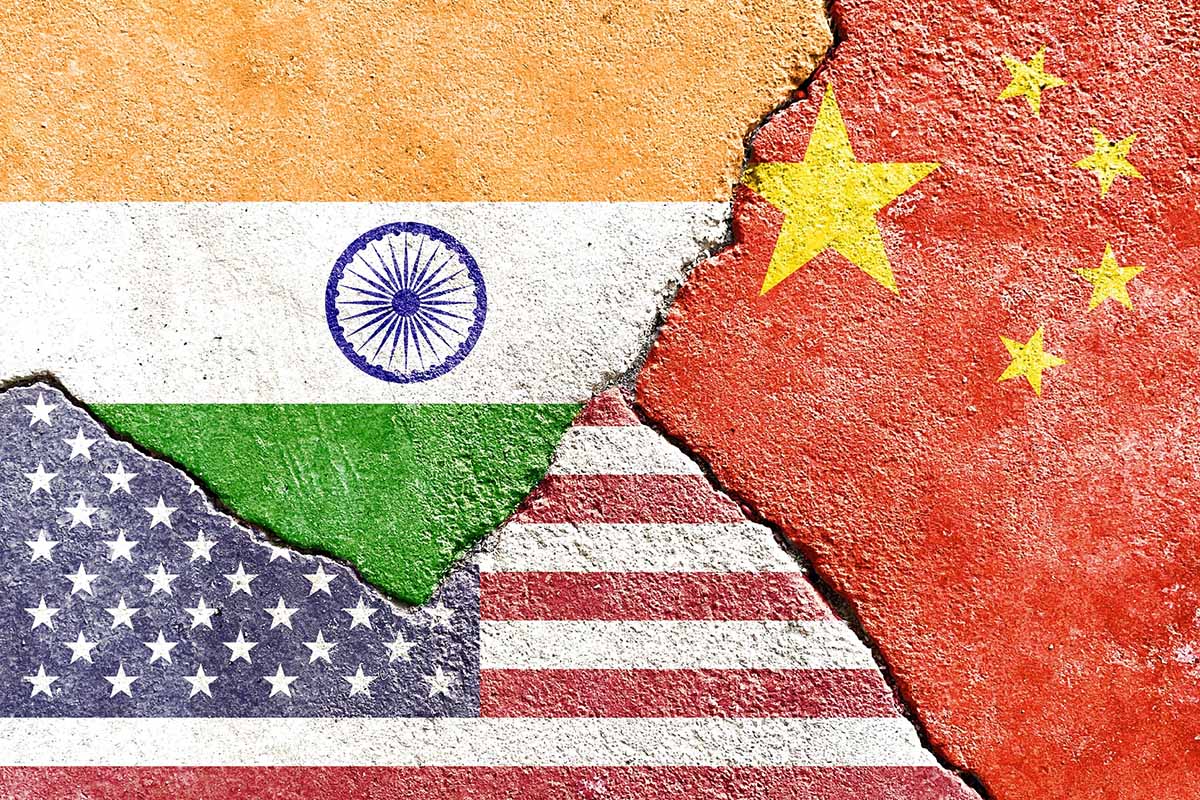United States, China & Others – The Rise of a new Cold War
December 9by Srishti Negi
“All the world’s a stage, and all the men and women merely players” – Shakespeare opined in the late 16th century, writing these memorable and insightful lines in his play ‘As You Like It’. And this dictum for ages immemorial has, consciously or unconsciously, represented the international stage at large. Now the world that this dictum portrays is the 21st century – marred by conflict, wars and catastrophe, and the players are our contemporary global leaders. However, two of these leaders are not mere players, they are the lead actors – who have the potential to change the course of this play. These players are – the leaders of the United States of America and China.
THE HISTORICAL BACKGROUND
The United States and China historically have had volatile relations. Both the countries found themselves on the rival sides during the Korean War in 1950, Taiwan Strait Crisis in 1954 and the Tibetan Crisis in 1959, after the creation of the Modern Chinese state in 1949. This was followed by the increasingly escalating relations during 1964 when China tested its’ first atomic bomb. These hostile ties, however, started to warm up after the Soviet-Sino split in March of 1969, which started a series of events to deepen the ties between the two countries to combat the increasing Soviet influence – an event marked by Henry Kissinger’s secret trip to China in 1971 wherein the US developed a ‘secret understanding’ with China. This was followed by United States recognizing the People’s Republic of China, normalizing relations and bilateral trade which was only interrupted by the events at Tiananmen Square.
WHAT LED TO THE CHANGE IN TIES?
Over the years, the relations have been fraught with tensions and disruptions. Firstly, the contentious issue of the Asia-Pacific Region has dominated both countries’ interests. The Asia-Pacific is a region which consists of, in this context, parts of Northern and Southern Asian along with Central and West Asia regions. The straining ties are a textbook example of what political scientists’ term the ‘Thucydides Trap’. Named after the Greek historian Thucydides, it refers to when an emerging power threatens to replace a dominant power from its’ position of prominence. The Indo-Pacific region has been a centre of attraction for both countries – it is a hub of economic, political and social activity and it is in the interests of both countries to court the region. The United States, whose power has been slowly dwindling, has historically held influence over the region and has continuously described itself as the ‘Pacific Power’. However, with the emergence of China as an important strategic partner of many countries in that region, the position of United States is hanging by a very precarious thread, that is threatening to break any time now.
Secondly, the Belt and Road Initiative plays an important role in this paradigm. In recent years, the project, launched in 2013 by President Xi Jinping, has played a significant role in increasing Chinese influence in Latin America, Africa and Asia i.e., in least developed and developing countries, which are hesitant to borrow from institutions such as the International Monetary Fund (IMF) and the World Bank. The Chinese BRI has filled the lacuna of these lending institutions by lending these countries credit at a low rates of interest to foster ‘new trade linkages, export markets and export China’s productive capacity’. By this initiative, the Chinese dragon hopes to rise again and spread its wings across the seas and lands yonder, threatening to disrupt, yet again, the United States hegemonic position across the globe.
BRI vs IMEC
The United States has been trying, ever since the conception and rise of the BRI, to counter the Chinese influence. First, the Obama and the Trump Administrations tried to contain this by announcing various infrastructural programmes in the least developed (LDCs) and developing countries. President Joe Biden escalated the efforts by announcing the Building Back Better World (B3W) in collaboration with the G7 countries, which failed to take off at the level anticipated. The nation, in 2017, also announced, on Japan’s insistence, the revival of QUAD (Quadrilateral Security Dialogue), which strengthens ties between India, America, Japan and Australia “on a shared vision for a Free and Open Indo-Pacific” which according to many observers and experts translates into tackling the meteoric rise of China, which is the common problem that these countries face.
Thus, the unveiling of the new India-Middle East-Europe Economic Corridor during the G20 Summit in India is quite significant in this context (in addition to the fact that it was unveiled when the Chinese leader didn’t attend the event in question). The economic corridor, starting as a shipping route from the states of Maharashtra and Gujarat will be connected to UAE. This will further be connected by a rail network to Saudi Arabia and Jordan and ultimately to Israel to the shores of the Mediterranean Sea – finally connecting to Greece and at the end, the whole of Europe. This initiative to strengthen the cooperation between the three important economic, political and social regional hubs, falls directly in confrontation with Xi Jinping’s grand scheme of reviving the ancient Silk Route through the Belt and Road Initiative (BRI) thus leading to an area of conflict.
WHAT DOES THIS MEAN FOR INDIA?
India has traditionally been touted as a rival power to China, the competition intensifying as both powers eye dominating to the point of achieving superpower status. With United States’ global influence slowly dwindling, thanks to messy domestic politics, these Asian powers seek to shape and write the discourse of the 21st century. In light of the Maldives Presidential Election, where an increased entrenchment of Chinese influence led to an ‘India Out’ campaign, the confrontation of the powers in the global ‘soft-power’ stage is drastically escalating. In addition to that is the ‘Chinese Debt Trap Diplomacy’ which in the case of Sri Lanka has nestled them in Indian arms whereas Nepal is now in a constant tug of war between the two geopolitical giants. With the situation between the United States and China increasingly becoming precarious, it creates an important opportunity for India to fill the lacuna left by both these powers.
To further expand on this idea – the Chinese Debt Trap Diplomacy resulted in countries like Sri Lanka and Pakistan mounting unsustainable amounts of debt due to high rates of interest. India can step in as a benign power and lend to these countries at a more favourable interest rate which can effectively consolidate India’s position in the subcontinent and elsewhere. India should also aim to provide unilateral investments in these countries, promoting infrastructure development by investing in strategic projects. The policy should, therefore, be first translated as a part of the Neighbourhood First Policy and should then be further extended to India’s other area of interest, the dynamic Southeast Asia, as part of the Act East Policy – capitalizing on the recent fissure between the Philippines and China over the South China Sea (delineation of which is also of importance to India, as the majority – that is over 55% – of its trade is by way of that sea route). India’s recent Healthcare Diplomacy during the COVID-19 pandemic, wherein it donated the vaccines to majority of the Asia-Pacific, at a time when other leading manufacturers were hoarding the vaccines, is one of the ways the Indian side has shown commitment to the Asia-Pacific cause. India has also been capitalizing its relations with the African Union, having spearheaded the latter’s recent induction into the G20, after intense lobbying and deliberation with the other members in the group. India should further nurture this relationship by investing in the continent, by lending benevolently in these countries and having a more engaged relationship with the continent as a whole.
The Indian side should also focus on maintaining a positive relationship with the United States of America, however they should avoid entering the alliance as a junior partner and rather should engage with America on equal footing. The initiatives, namely QUAD, I2U2, IMEC etc, are important stepping stones and engagement points for both nations, not only to effectively cooperate on the economic, political and the security front, but to counter the Chinese threat. It is largely recognized that the bilateral relationship between these two countries is a ‘Marriage of Convenience’ rather than Convergence, with the United States defining and redefining its ties with India as per its whims and fancies. India should also try to establish strong relationships with those states who feel disgruntled and disenchanted with the West, which include, again, the developing and the developed nations, who often find themselves as sacrificial lambs to the developed nations’ cause. India, if it effectively wants to cement itself as the leader of the Global South, should engage with these nations and advocate for their cause on the global stage. Thus, not only can India effectively balance its position globally, but can also consolidate its interests to emerge as a leading power.
However, it is increasingly clear that the need of the hour is a multipolar world where the demands of different countries and groupings are highlighted and addressed unequivocally. The only question that stands unanswered here is – whether the two global giants, the United States and China, are ready to embrace this global order? Or do they hold on to the nostalgic and increasingly seductive idea of unlimited power and influence, paving the way for a new Cold War.






